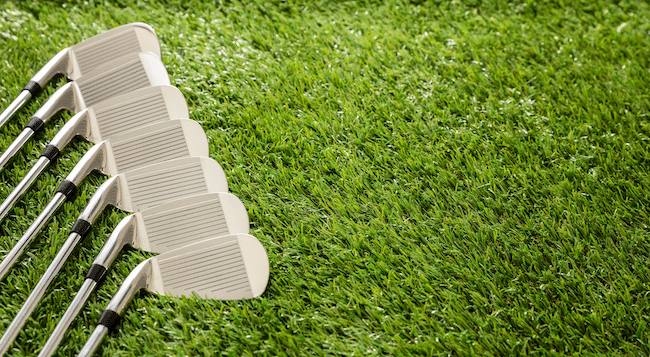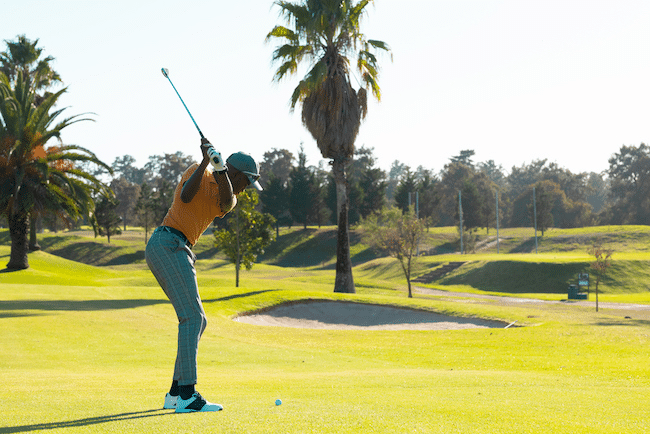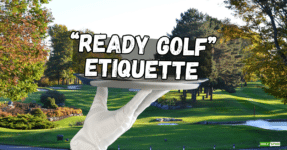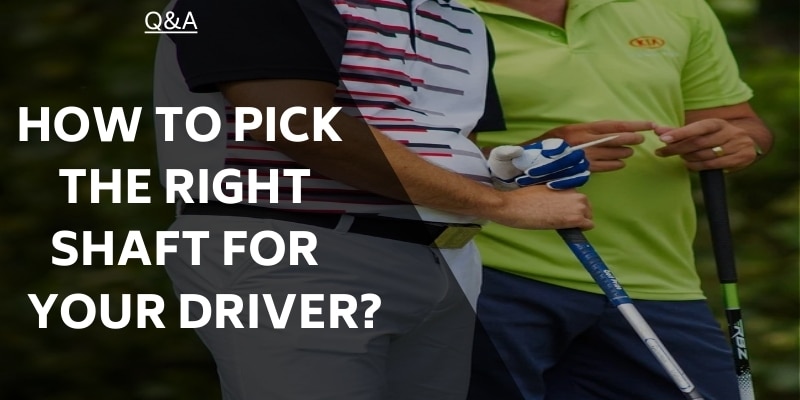Long irons are used to hit shots for longer distances. Typically, long irons include the five, four, and three irons. Although not as prevalent anymore, the two and one irons are also considered long irons.
The long iron tends to be a more difficult club to hit than a mid and short iron. This is because longer clubs, with less loft, require more skill to maximize their benefits. In addition, golfers with slower swing speeds will find long irons challenging to get into the air and carry the distances they are meant to carry.
But with the right practice, you can use these tools to take your game to the next level.
Here are 7 tips on how to hit long irons:
- Place The Ball More Forward In Your Stance
- Lighten Up Your Grip Pressure
- Don’t Take Your Club Back Too Quickly
- Use A Flat Lead Wrist at The Top and at Impact
- Follow The Proper Downswing Sequence: Hips→Chest→Hands→Clubface→Impact→Release
- Focus on a Proper Pressure Shift
- Work on Increasing Your Clubhead Speed
You don’t want to miss a step and hurt your game, so read through the entire post as we break down each tip.
In this article, I will cover all you need to know about the long iron, including:
- What is a long iron?
- The importance of mastering long irons
- 7 tips for hitting long irons better
- Common mistakes hitting long irons
Let’s dive in!
What Are Long Irons?

Long irons are typically considered to include the five iron and up. However, with the prevalence of hybrids and driving irons, the more traditional three, two, and even one iron are seen far less in golf bags.
Long irons are considerably more difficult to hit. This is why so many more players carry hybrids and driving irons today. It is even typical for iron sets to start at only a four-iron and sometimes even a five-iron.
These clubs are tricky because the added length and less loft make it harder to get the ball airborne enough to be effective. A golfer must generate sufficient clubhead speed for long irons to carry the trajectory and distance they are intended to. Unfortunately, this is something that a large majority of golfers need help to achieve consistently.
Read more: How to Hit Irons Pure
The Importance of Mastering Long Irons

For those that can learn how to hit the long iron well, it can be a massive boost for their game. The challenge, however, is that long irons are hard to hit.
If a golfer can hit long irons at good flight trajectories and carry the ball at reasonable distances, then the long iron is a great tool. The chart below shows the approximate average carry distances of long irons based on a male golfer at certain handicaps and average clubhead speeds.
The reason for the dramatic drop off in carry distance for middle and higher handicaps is the general lack of club head speed and center-face contact. Both are necessary to get the benefits of a long iron.
| Club | Average Tour Professional | Low Handicap/Higher Clubhead Speed | Middle Handicap/Average Clubhead Speed | High Handicap/Slow Clubhead Speed |
| 2-Iron | 225 | 220 | 200 | 160 |
| 3-Iron | 215 | 200 | 190 | 155 |
| 4-Iron | 205 | 190 | 180 | 150 |
| 5-Iron | 195 | 180 | 170 | 140 |
It is important to note that the carry distance, not the total distance, is generally most important with irons. In most instances, you hit your irons to a target, hoping to carry the ball the distance needed. This is because most greens on a hole require a shot to come in from the air rather than rolling on the ground.
For higher handicappers, who generally can not create the clubhead speed necessary for good long iron play, flying a shot the correct height is challenging.
When carrying a water hazard, bunker, or getting the ball to a back tier on a green, carry distance is vital. Having the shot land soft from a more descending trajectory is essential for holding the green.
Check this out: How To Hit A Low Golf Shot & Keep Scoring In Windy Conditions!
7 Tips To Help You Hit Long Irons Better
The following tips are intended to help golfers of all abilities get the most out of their long irons. In addition, these tips should be helpful for all golfers with trouble hitting long irons.
1. Place The Ball More Forward In Your Stance
A proper long iron ball position is essential for hitting long irons well.
You need to hit down on the ball to hit any iron well. That is golf physics 101. The club’s loft is made in such a way that requires the clubface to come into contact with the ball at a particular angle.
You want to play the ball more forward in your stance for your long irons. In general, that is just inside your left heel.
If your ball placement is too far back in your stance, you are making a club with a lower loft have even less. This will make getting the ball airborne enough more difficult. If you have a slower swing speed and a ball back too far, that will make getting the ball up almost impossible.
Learn more: The Best Single Length Irons
2. Lighten Up Your Grip Pressure
Proper grip pressure is generally essential, but even more so with the more difficult-to-hit long irons. Gripping too hard creates tension through your forearms, up through your shoulders, and through your whole upper body. Tension is a speed killer.
You must be able to turn back and through freely as you swing.
Test your grip pressure by squeezing your club hard and then easing up to barely holding it. Do that a few times. As you squeeze your club hard, feel the tension you create in your forearms and shoulders. Then, as you release it slowly, feel the tension go away.
When you are at your maximum squeeze, tag that feeling as a ten on a 1-10 scale. Then, as you release the tension and get it down to barely holding the club, tag that as a one on that 1-10 scale.
When you swing your clubs, especially your longer irons, you want your grip pressure at about a four on your personal 1-10 scale.
3. Don’t Take Your Club Back Too Quickly
Many golfers that struggle to hit their long irons well often are at fault for this problem. What I am referring to is taking the club back far too fast.
Taking the club back too quickly and abruptly to get “faster” damages your swing.
You want to start the club back low, slow, and in one piece. The “one piece” portion refers to the shoulders driving the arms and club back together as they rotate.
This is a very common piece of advice, but an important one. The idea of the swing is to build up power slowly. Then, that power is stored at the top of your swing and released into the ball as you work into impact.
4. Use A Flat Lead Wrist at The Top and at Impact
Your lead wrist is one of the most essential parts of your body in golf. The reason is that it mirrors what the face of your club is doing throughout the swing.
At the top of your swing, you want your lead wrist flat or slightly in flexion, otherwise known as bowed. Having your lead wrist in extension or cupped is no good. This means that the clubface is almost certainly open.
As you work down from the top of your swing and into impact, you want that lead wrist flat or ever so slightly bowed. This will help you reach a good impact position with the hands leading and the clubface square to the target line.
A fantastic training aid for training your wrist angles is the Hackmotion wrist sensor.
5. Follow The Proper Downswing Sequence: Hips→Chest→Hands→Clubface→Impact→Release
Understanding the proper sequencing from the top of your swing and down through impact is critical for hitting your long irons well.
The proper downswing sequence is as follows:
Hips→Chest→Hands→Clubface→Impact→Release
Many golfers are impatient in the transition from the backswing to the downswing. With a desire to swing for speed and a hazy understanding of the proper sequence, many start the downswing with their hands. Unfortunately, by doing this, a few bad things happen.
First, an over-the-top path results from the hands leading from the top. This is an outside-to-inside swing path. This will lead to a pulled shot or, more often, a slice. Secondly, when the hands lead from the top, it is common to have the hips work toward the ball coming into impact. This is the dreaded “early extension.”
You want to lead with the hips on the downswing and have them rotate and clear out of the way. This will allow the chest to unwind next, followed by the hands and, finally, the club head. This will help create a good impact position.
6. Focus on a Proper Pressure Shift
The pressure shift is different from the weight transfer that is more commonly referenced.
Weight is your mass or what you weigh. When you move your weight or mass, that is what is generally referred to as weight transfer.
Pressure is the vertical force measured within your feet and how you are pressing into the ground. You can shift pressure by moving your mass or weight. But, at the same time, you can do so and still keep your weight or mass centered.
The best players in the world actually have pressure moving into their lead foot, even before the hands reach the top of their backswing. This allows them to clear their hips much faster and more efficiently than most amateurs.
You will reinvent your game by understanding and incorporating proper pressure and mass movements in the swing. You will have the ability to deliver the clubhead into the ball at impact like a tour professional.
7. Work on Increasing Your Clubhead Speed
Working on increasing your clubhead speed will help you become a much better long-iron player. Speed is necessary for getting the full benefits of long irons.
The best way to work on increasing your speed is by using any of the current speed training protocols on the market. The following are some great options to consider.
Our Favorite Training Aids To Increase Your Clubhead Speed:
3 Common Mistakes Hitting Long Irons
Why can’t I hit my long irons? Do you ask yourself this question often?
The following are the most common mistakes I see in golfers attempting to hit their long irons. Do you do any of these?
- Trying to lift, or help the ball up- This is very counterintuitive. While it seems helpful, the reality is you need to let the loft of the club do the work for you. The only way it can do that is by you hitting down into the ball.
- Trying to start the downswing with the hands- To create more speed, golfers will try to start the downswing with their hands. This will cause a poor swing path and increase the chances of early extension at impact. Both will lead to poor ball contact. Lead with the hips on your downswing.
- Bad ball position at setup- You must have the ball up in your stance with long irons. Having it back too far will hurt your chances of airborne getting the ball.
Read on: The 8 Most Forgiving Irons
Summing It Up
Long irons can be a fantastic tool for playing great golf. At the same time, they are challenging clubs for many golfers to hit. Therefore, arming yourself with knowledge about how long irons should work is an essential first step to hitting them better. That was one of my goals in this article.
Additionally, the seven tips above can help you learn how to hit long irons pure.
FAQ’s
Should I Use Long Irons or Hybrids?
I suggest using hybrids in place of long irons. Especially if you are a middle to higher handicapper. Hybrids have become very popular, and rightfully so. The design of these clubs helps golfers get less lofted clubs in the air much easier. Even tour professionals carry hybrids in their bags today.
What Is the Longest Iron I Should Have?
Manufacturers in today's marketplace generally start complete iron sets with four iron. In some cases, they will offer sets starting with a five iron. You can certainly buy a three-iron or even a two-iron in some cases. You should only go with a five iron and down for your irons. Get two hybrids at lofts to replace your four and three irons.
Brendon is Class A PGA Professional and founded Little Linksters, LLC, and its nonprofit arm, the Little Linksters Association for Junior Golf Development. He won 25+ prestigious industry honors, including the 2017 PGA National Youth Player Development Award. He graduated from the PGA of America Management Program and has a handicap index of 7.8.
He has played golf for over 40 years and currently plays twice a month at the Eagle Dunes Golf Club near Sorrento, Florida. He loves Srixon clubs and plays a ZX5 driver with Z 585 irons. He's written over 60 articles on GolfSpan and specializes in sharing tips to improve your golf game. You can connect with Brendon at LinkedIn, X, IG, FB, his website, or BrendonElliott@pga.com.







